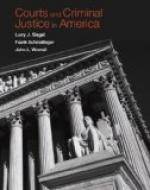the heart; a striker was killed by a twenty-five-pound
piece of flagging thrown from a roof; there was a
gun fight of colored men at Madison, Wisconsin, at
which three were shot; a gang of negro ruffians killed
and mutilated a white woman (with a baby in her arms)
and her husband; masked robbers called a man to his
barn at Winston-Salem, North Carolina, and cut his
throat; an Italian was found with his head split in
two by a butcher’s cleaver; a negress in Lafayette,
Louisiana, killed a family of six with a hatchet;
a negro farmer and his two daughters were lynched
and their bodies burned by four white men (who will
probably also be lynched if caught); a girl of eleven
shot her girl friend of about the same age and killed
her; several persons were found stabbed to death;
a plumber killed his brother (also a plumber) for
saying that he stole two dollars; a murderer was shot
by a posse of militia in a cornfield; a card game
at Bayonne, New Jersey, resulted in a revolver fight
on the street in which one of the players was killed;
bank robbers killed a cashier at twelve o’clock
noon; a jealous lover in Butte, Montana, shot and
killed his sweetheart, her father, and mother; a deputy
sheriff was murdered; burglars killed several persons
in the course of their business; Kokolosski, a Pole,
kicked his child to death; and a couple of dozen people
were incidentally shot, stabbed, or otherwise disposed
of in the course of quarrels over the most trivial
matters. In almost no case was there what an
intelligent, civilized man would regard as an adequate
reason for the homicide. They killed because
they felt like killing, and yielded to the impulse,
whatever its immediate origin.
This conclusion is abundantly supported by the figures
of the ‘Chicago Tribune’ for the seven
years ending in 1900, when carefully analyzed.
During this period 62,812 homicides were recorded.
Of these there were 17,120 of which the causes were
unknown and 3,204 committed while making a justifiable
arrest, in self-defence, or by the insane, so that
there were in fact only 42,488 felonious homicides
the causes of which can be definitely alleged.
The ratio of the “quarrels” to this net
total is about seventy-five per cent. There were,
in addition, 2,848 homicides due to liquor—that
is, without cause. Thus eighty per cent of all
the murders and manslaughters in the United States
for a period of seven years were for no reason at
all or from mere anger or habit, arising out of causes
often of the most trifling character.
Nor are the conclusions changed by the figures of
the years between 1904 and 1909.
During this period 61,786 homicides were recorded.
Of these there were 9,302 of which the causes were
not known, and 2,480 committed while making a justifiable
arrest, in self-defence, or by the insane, leaving
50,004 cases of felonious homicides of known causes.
Of these homicides, 33,476 were due to quarrels and
4,799 to liquor, a total of 38,275 out of the 50,004
cases of known causes being traceable in this, another
seven years, to motives the most casual.




